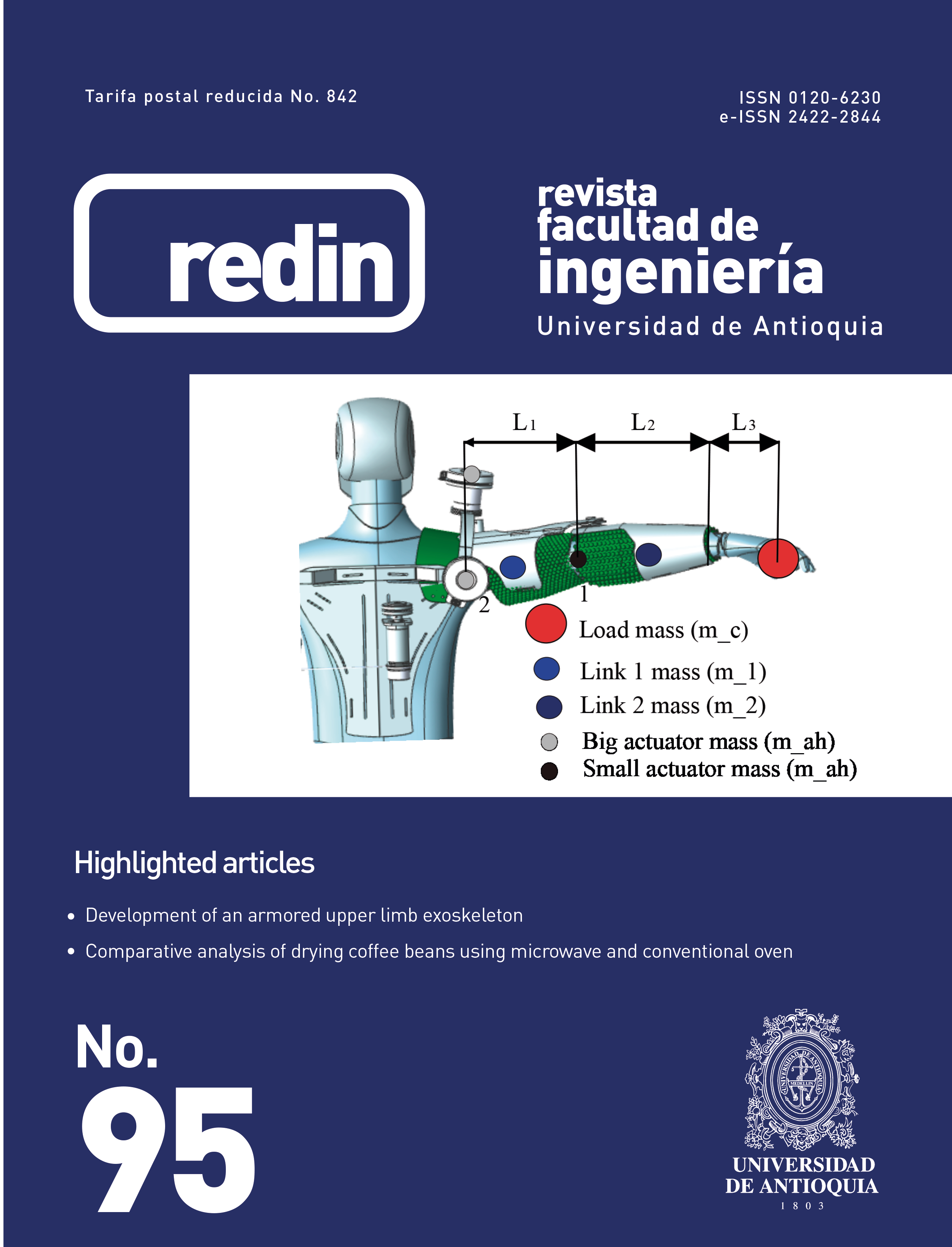Effect of processing technology on the physicochemical properties of non-centrifugal cane sugar (NCS)
DOI:
https://doi.org/10.17533/udea.redin.20190839Keywords:
non-centrifugal cane sugar, physical and chemical properties, ward furnace, evaporationAbstract
Non-centrifugal cane sugar (NCS) is a natural sweetener with beneficial health properties. This is traditionally produced in an oven which has had technological variations. Therefore, the present study focuses on determining the effect that NCS processing technology has on its physicochemical properties. In this study, two contrasting technologies were selected: the first one corresponds to the traditional furnace, characterized by a flat combustion chamber and hemispherical pan. The second one corresponds to the furnace with a ward type combustion chamber and modified pan. The variety of sugarcane selected was RD 75-11. The physical and chemical parameters evaluated were hydrogen potential (pH), total acidity (TA), solid soluble content soluble (SSC), ash, minerals, reducing sugars, color, moisture content and heat capacity. The technology with ward- type combustion chamber and modified pan managed to concentrate the oBrix of syrup to NCS in a 36.03% unlike the traditional furnace (32.59%). The two technologies used allowed obtaining NCS with an average caloric value of 14684.9 J g-1 and soluble solid content of 90.1oBrix. It was found that the NCS is a source of minerals such as potassium (3.55 g kg-1), calcium (2.25 g kg-1) and phosphorus (0.3 g kg-1).
Downloads
References
Colombian technical standard 1311, ICONTEC, 2009.
W. Jaffé, “Health effects of non-centrifugal sugar (ncs): A review,” Sugar Tech, vol. 14, no. 2, pp. 87–94, Jun. 2012.
(2016) Food and Agriculture Organization of the United Nations, FAOSTAT. FAO. Accessed Nov. 01, 2018. [Online]. Available: http://www.fao.org/faostat/es/#home
G. Rodriguez, H. Garcia, Z. Roa, and P. Santacoloma, “Panela production as a strategy for diversifying incomes in rural area of latin america,” FOOD AND AGRICULTURE ORGANIZATION OF THE UNITED NATIONS, Rome, IT, Tech. Rep., 2007.
W. Jaffé, “Nutritional and functional components of non centrifugal cane sugar: A compilation of the data from the analytical literature,” Journal of Food Composition and Analysis, vol. 43, November 2015. [Online]. Available: https://doi.org/10.1016/j.jfca.2015.06.007
H. García, L. Albarracin, A. Toscano, N. Santana, and O. Intuasty. (2007) Guía tecnológica para el manejo integral del sistema productivo de caña panelera. Corporación Colombiana de Investigación Agropecuaria. Colombia. [Online]. Available: https://bit.ly/2OcYZH9
M.Tarazona, J. Viegas, M. Moldao, and E. Aguayo, “Bioactive compounds from flesh and by-product of spanish freshcut watermelon cultivars,” Journal of the Science of Food Agriculture, vol. 91, no. 5, March 30 2011. [Online]. Available: http://doi.org/10.1002/jsfa.4250
M. Tarazona and E. Aguayo, “Assessment of by-products from fresh-cut products for reuse as bioactive compounds,” Food Science and Technology International, vol. 19, no. 5, July 15 1996. [Online]. Available: http://doi.org/10.1177/1082013212455346
“Nitrogen, Kjeldahl, Total (Colorimetric; Titrimetric; Potentiometric),” EPA, Environmental Protection Agency, Tech. Rep. Method 351.3, 1978.
Norma técnica colombiana 5404: Calidad del suelo, Determinación de Boro, ICONTEC, 2011.
“Official Method 923.09 in Lane and Eynon general volumetric method,” AOAC, Association of Official Analytical Chemists, International, Tech. Rep. 923.09.
Testing of solid and liquid fuels - Determination of gross calorific value by the bomb calorimeter and calculation of net calorific value, DIN 51900-1:2000-04, 2000.
Solid mineral fuels, Determination of gross calorific calue by the bomb calorimetric method, and calculation of net calorific value, International Organization for Standardization 1928:1995, 1995.
N. Durán, Reingeniería panelera, 1st ed. Colombia: Buhos Editores, 2010.
M. Guerra and M. Mujica, “Physical and chemical properties of granulated cane sugar ”panelas”,” Food Science and Technology, vol. 30, no. 1, January/March 2010. [Online]. Available: http://dx.doi.org/10.1590/S0101-20612010005000012
P. Jackson and et al, “Management of ash/impurity ratio in sugarcane: relative effects of genotypes, and N and K fertiliser rates,” Australian journal of agricultural research, vol. 59, no. 9, pp. 795–801, 2013.
J. Ramírez, O. Insuasty, and C. Viveros, “Comportamiento agroindustrial de diez variedades de caña de azúcar para producción de panela en santander, colombia. corpoica,” Ciencia y Tecnología Agropecuaria, vol. 15, no. 2, pp. 183–195, 2014.
P. Rao, M. Das, and S. Das, “Changes in physical and thermophysical properties of sugarcane, palmyra-palm and date-palm juices at different concentration of sugar,” Journal of Food Engineering, vol. 90, no. 4, February 2009. [Online]. Available: https://doi.org/10.1016/j.jfoodeng.2008.07.024
S.Kadri, R. Zaluski, and R. Orsi, “Nutritional and mineral contents of honey extracted by centrifugation and pressed processes,” Food Chemistry, vol. 218, September 12 2016. [Online]. Available: https://doi.org/10.1016/j.foodchem.2016.09.071
B. F. P. Database. United States Department of Agriculture. Accessed jun. 17, 2017. [Online]. Available: https://ndb.nal.usda.gov/ndb/search/list
S. Taghi and S. Jafari, “The importance of minerals in human nutrition: Bioavailability, food fortification, processing effects and nanoencapsulation,” Trends in Food Science and Technology, vol. 62, April 2017. [Online]. Available: https://doi.org/10.1016/j.tifs.2017.02.017
R. Núñez, B. Rivas, R. Hernández, and M. Chirinos, “Contenido de azúcares totales, reductores y no reductores en agave cocui trelease,” Multiciencias, vol. 12, no. 2, pp. 129–135, 2012.
Instituto Colombiano de Bienestar Familiar-ICBF. (2015) Tabla de composición de alimentos colombianos (TCAC). Digiprint editores SAS. [Online]. Available: https://bit.ly/2FbIoys
Published
How to Cite
Issue
Section
License
Copyright (c) 2020 Revista Facultad de Ingeniería Universidad de Antioquia

This work is licensed under a Creative Commons Attribution-NonCommercial-ShareAlike 4.0 International License.
Revista Facultad de Ingeniería, Universidad de Antioquia is licensed under the Creative Commons Attribution BY-NC-SA 4.0 license. https://creativecommons.org/licenses/by-nc-sa/4.0/deed.en
You are free to:
Share — copy and redistribute the material in any medium or format
Adapt — remix, transform, and build upon the material
Under the following terms:
Attribution — You must give appropriate credit, provide a link to the license, and indicate if changes were made. You may do so in any reasonable manner, but not in any way that suggests the licensor endorses you or your use.
NonCommercial — You may not use the material for commercial purposes.
ShareAlike — If you remix, transform, or build upon the material, you must distribute your contributions under the same license as the original.
The material published in the journal can be distributed, copied and exhibited by third parties if the respective credits are given to the journal. No commercial benefit can be obtained and derivative works must be under the same license terms as the original work.










 Twitter
Twitter